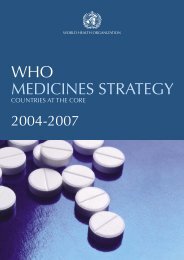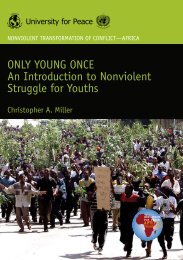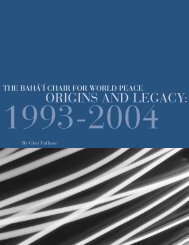MUCH is be<strong>in</strong>g written <strong>in</strong> the Western media about the ongo<strong>in</strong>g genocidal war<strong>in</strong> Darfur, the Sudan’s westernmost prov<strong>in</strong>ce, an area approximately the size<strong>of</strong> France. Much is be<strong>in</strong>g written on what is happen<strong>in</strong>g on the ground, muchless about the <strong>cause</strong>s. I write here <strong>as</strong> an historian <strong>of</strong> Darfur and <strong>as</strong> an observer <strong>of</strong>the Sudanese political scene.The <strong>conflict</strong> is be<strong>in</strong>g presented <strong>in</strong> the media <strong>as</strong> a war between Arabs and Africans,with Arab militi<strong>as</strong>, called janjawid, carry<strong>in</strong>g out m<strong>as</strong>sacres, rape and pillagewith the support <strong>of</strong> the Khartoum Government.This simplifies and misrepresents a very complex reality. Darfur comprises threeecological and ethnic ‘zones’; the northern zone <strong>in</strong>cludes Arabs, Zayyadiyya and theso-called ‘Northern Rizayqat’, who <strong>in</strong>clude the Irayqat, to whose rul<strong>in</strong>g family thejanjawid leader, Musa Hilal, belongs and non-Arab (ma<strong>in</strong>ly Zaghawa and Bideyat);all are or have been traditionally camel nomads. The central zone on both sides <strong>of</strong>the Jabal Marra mounta<strong>in</strong> range is <strong>in</strong>habited largely by non-Arab sedentary farmerssuch <strong>as</strong> the Fur, M<strong>as</strong>alit, Tama, Qimr, Mima and others, cultivat<strong>in</strong>g millet and speak<strong>in</strong>gtheir own languages, while <strong>in</strong> the south there are a series <strong>of</strong> Arabic-speak<strong>in</strong>gcattle nomads—the Baqqara; the Bani Halba, Habbaniyya, Rizayqat and Taaisha arethe ma<strong>in</strong> groups. Language <strong>in</strong> itself is not an ethnic marker; groups like the Birgedand the Berti have lost their own language with<strong>in</strong> the l<strong>as</strong>t century. They now speakArabic, but do not regard themselves <strong>as</strong> Arabs. All are Muslim and no part <strong>of</strong> Darfurw<strong>as</strong> ever ethnically homogenous. For example, a successful Fur farmer would <strong>in</strong>vest<strong>in</strong> cattle; once the cattle reached a certa<strong>in</strong> number, it would be more pr<strong>of</strong>itable tocross the ethnic frontier and ‘become’ Baqqara and <strong>in</strong> a few generations his descendantswould have an ‘authentically’ Arab genealogy.This ethnographic map derives from research from the 1970s and before. It isalmost certa<strong>in</strong>ly out-<strong>of</strong>-date, given the general rapidity <strong>of</strong> change <strong>in</strong> Africa. Neverthe-lessmy read<strong>in</strong>g <strong>of</strong> Human Rights Watch and other reports is that the b<strong>as</strong>ic factson the ground have not changed that greatly.Historically, Darfur <strong>as</strong> a state w<strong>as</strong> both a Muslim sultanate and an African sacralk<strong>in</strong>gship, established <strong>in</strong> around 1650 and heir to a very old tradition <strong>of</strong> stateformation <strong>as</strong>sociated with two ethnic groups still present <strong>in</strong> Darfur, the Daju andTunjur (both non-Arab), go<strong>in</strong>g back to probably the twelfth century. The sultanatefrom the mid-seventeenth century w<strong>as</strong> dom<strong>in</strong>ated by the Fur people from whom therul<strong>in</strong>g dyn<strong>as</strong>ty came, but ruled by a title-hold<strong>in</strong>g elite recruited from all the majorethnic groups. The sultanate had a complex adm<strong>in</strong>istrative system, partly Muslim,partly draw<strong>in</strong>g on older Sudanic state-formation structures; under the sultans (forangeri <strong>in</strong> Fur), the people were ruled through an adm<strong>in</strong>istration that w<strong>as</strong> efficientand by the eighteenth century literate <strong>in</strong> Arabic, even though the court languagerema<strong>in</strong>ed Fur. The p<strong>in</strong>nacle <strong>of</strong> the state w<strong>as</strong> the f<strong>as</strong>hir or al-F<strong>as</strong>hir, the prov<strong>in</strong>ce’scapital from the 1790s, a palace complex that served <strong>as</strong> a ritual, political and re-24
distributive centre and where the royal women, especially the sultan’s senior sister,played crucial roles. My impression, from the many documents I have collectedand read from the period, is that the mesak<strong>in</strong> or ord<strong>in</strong>ary people could expect nottoo much zulm or ‘oppression’. In short, it w<strong>as</strong> a well-run state. One example is adecree from the l<strong>as</strong>t sultan, ‘Ali D<strong>in</strong>ar (1898-1916), to his chiefs po<strong>in</strong>t<strong>in</strong>g to thefact that the ra<strong>in</strong>s that year were exceptionally good and order<strong>in</strong>g them to plant anextra field, whose yield w<strong>as</strong> to be stored for the future. The evidence we have fromthe period <strong>of</strong> the sultanate, which is abundant, is that what would now be calledecological concerns, namely control over land-rights, water and graz<strong>in</strong>g, were verycarefully monitored; under ‘Ali D<strong>in</strong>ar these concerns are very well documented.Under the sultanate the settled peoples, essentially non-Arab, were able to moreor less control (or keep out) the nomads by hav<strong>in</strong>g a state on their side; the sultanate’sultimate sanction w<strong>as</strong> heavy cavalry, rid<strong>in</strong>g imported horses (much larger thanthe local breeds) and wear<strong>in</strong>g cha<strong>in</strong>-mail. The nomads could not stand up aga<strong>in</strong>stthem; here the camel nomads <strong>of</strong> the north were more vulnerable than the Baqqara,who were always a problem for the sultans, s<strong>in</strong>ce they could withdraw ever furthersouth <strong>in</strong> the Western Bahr al-Ghazal. As an historian I am struck by the parallelsbetween the present situation, although today the <strong>conflict</strong> is much bloodier, andthe position <strong>in</strong> the 1880s after the destruction <strong>of</strong> the sultanate <strong>in</strong> 1874 at thehands <strong>of</strong> a Northern Sudanese slave-trader, al-Zubayr P<strong>as</strong>ha, when a series <strong>of</strong> sultanicpretenders attempted to keep the <strong>cause</strong> <strong>of</strong> Darfur’s <strong>in</strong>dependence alive—my<strong>in</strong>formants called this period (1874-98) Umm Kwakiyya, the ‘kill<strong>in</strong>g period’. From myfield-notes written <strong>in</strong> the 1970s, Umm Kwakiyya sounds very much like today.When the sultanate w<strong>as</strong> restored <strong>in</strong> 1898 by ’Ali D<strong>in</strong>ar he spent most <strong>of</strong> his reigndriv<strong>in</strong>g the nomads, north and south <strong>of</strong> the settled area, back, until he w<strong>as</strong> killedby the British <strong>in</strong> 1916. The British then discovered that they had no alternativebut to cont<strong>in</strong>ue his policy. They also kept the old rul<strong>in</strong>g elite <strong>in</strong>tact; <strong>in</strong>deed many <strong>of</strong>the educated Darfurians <strong>of</strong> today descend from that elite. A strik<strong>in</strong>g symbol <strong>of</strong> thiscont<strong>in</strong>uity w<strong>as</strong> that up until the 1980s, the prov<strong>in</strong>ce governor lived <strong>in</strong> ’Ali D<strong>in</strong>ar’spalace and had his <strong>of</strong>fice <strong>in</strong> ’Ali D<strong>in</strong>ar’s throne room with the sultan’s throne beh<strong>in</strong>dhis desk. One flaw <strong>in</strong> British colonial policy w<strong>as</strong> to attempt to fix all ‘tribes’ <strong>in</strong> theirdars or homelands <strong>as</strong> if they had immutable boundaries; a second w<strong>as</strong> to legislateland-use and ownership <strong>as</strong> ‘tribal’ or communal, ignor<strong>in</strong>g the sultanate’s practice <strong>of</strong>grant<strong>in</strong>g land <strong>as</strong> freehold.In the colonial period (1916-56) Darfur w<strong>as</strong> a backwater ruled by a handful <strong>of</strong>British <strong>of</strong>ficials; its only resource be<strong>in</strong>g the young men who migrated e<strong>as</strong>tward t<strong>of</strong><strong>in</strong>d work <strong>in</strong> the cotton schemes between the Blue and White Niles.After <strong>in</strong>dependence <strong>in</strong> 1956, the situation did not change much, save for thebuild<strong>in</strong>g <strong>of</strong> a railway to Nyala <strong>in</strong> 1959, which pulled the centre <strong>of</strong> gravity southwardsto Nyala. There w<strong>as</strong> some economic development <strong>in</strong> the fertile region around25
- Page 1: ENVIRONMENTAL DEGRADATIONAS A CAUSE
- Page 4 and 5: Cover Photo:AU forces patrol Darfur
- Page 7 and 8: PREFACEThese essays were originally
- Page 9 and 10: AcknowledgementsThe conference was
- Page 11 and 12: Executive SummaryByMary E. King and
- Page 13 and 14: the theme of the conference, outlin
- Page 15 and 16: • The question of warrior culture
- Page 17 and 18: Deryke Belshaw, University of East
- Page 19 and 20: area in West Darfur of 1.5m feddans
- Page 21 and 22: on the interaction between conflict
- Page 23: Conflict In DarfurHistorical andCon
- Page 28 and 29: sues quite separate. Evidence for t
- Page 30 and 31: FOOTNOTES1It is not my purpose here
- Page 32 and 33: 20On other emerging ethnically-base
- Page 34 and 35: IntroductionTHE Greater Darfur regi
- Page 36 and 37: 2. Agriculture (Farming)Crop farmin
- Page 38 and 39: Secondly, the demand for mutton and
- Page 40 and 41: groundnut and sesame as sources of
- Page 42 and 43: The situation of drinking water in
- Page 44 and 45: ReferencesConference, Meleet, North
- Page 46 and 47: IntroductionTHE residents of the Um
- Page 48 and 49: Phase Two:This phase was a monitori
- Page 50 and 51: zone southward — and to use these
- Page 52 and 53: • Some water points in places lik
- Page 54 and 55: This study and the seminar organize
- Page 57 and 58: Land Tenure,Land Use andConflicts i
- Page 59 and 60: tain innovations called hakura (pl.
- Page 61 and 62: mands for food production. All thes
- Page 63 and 64: Hashab Tenure SystemHashab ownershi
- Page 65 and 66: co-exist at the local level where e
- Page 67 and 68: IndigenousInstitutions andPractices
- Page 69 and 70: abs. In the past they had been invo
- Page 71 and 72: Sufi OrderSufi orders are religious
- Page 73 and 74: Native Administration, i.e. Tribal
- Page 75 and 76:
Rizayqat homeland is at the extreme
- Page 77 and 78:
esearchers and statesmen. A bigger
- Page 79:
ReferencesBakheit, Jaafar M.Ali. 19
- Page 82 and 83:
IntroductionWHILE in the Sudan prot
- Page 84 and 85:
ReferencesHarir, S. 1993. ‘Arab B
- Page 86 and 87:
IntroductionTHE Darfur Region lies
- Page 88 and 89:
Table (1)Water program for Darfur 2
- Page 90 and 91:
anging from 150mm the north and 450
- Page 92 and 93:
ReferencesIbrahim, Abdel Rahman Abb
- Page 94 and 95:
CONCLUSIONTHE collection of papers
- Page 96 and 97:
GLOSSARYAjawidArdaBaqqaraDarDukhnFa
- Page 99 and 100:
A Darfur Timeline99
- Page 101 and 102:
1898 On the eve of the battle of Om
- Page 103 and 104:
Bibliography103
- Page 105 and 106:
El Mahdi S. Mohamed. 1979. Introduc
- Page 107 and 108:
Tothill, J.D. 1948. Agriculture in
- Page 109 and 110:
Biographical Sketch: Rex Sean O’F
- Page 111 and 112:
111











